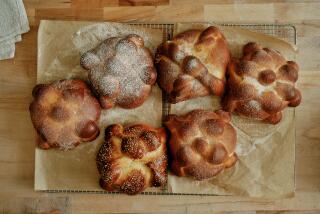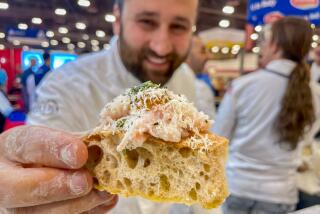Bread Winner
- Share via
IT MUST HAVE BEEN BACK IN THE MID-1970S. I remember the olive oil dribbling off the focaccia onto my groovy persimmon bell-bottoms. I was standing in front of the Liguria Bakery on Washington Square in San Francisco’s North Beach neighborhood. My mother, an Italian immigrant, tore off a piece of the funny-looking flatbread and popped it into her mouth. She asked, in Italian, “Good, no? It’s Genoese.” I chewed the lusciously oiled, salty slab but did not flip for it. Then she scolded, “When your father and I took the ship from Genoa to Los Angeles, they served us focaccia on board.”
What my meat-and-potatoes father from Garden Grove must have thought back then, in 1950, about the dimpled flatbread and the prospect of his Italian wife crossing the culinary deserts of Southern California, I can only imagine. Fifty years later, however, the deserts have been made to bloom: focaccia abounds in bakeries, delis and restaurants across America, including, no doubt, in Garden Grove. More often than not, though, the focaccia you find nowadays is studded and topped with fistfuls of rosemary or sage, with grated Parmigiano-Reggiano to boot, not to mention eggplant, olive paste, capers and truffles. Don’t get me wrong--I think these bounteous New World interpretations are delicious. But, as I found out in focaccia’s cradle, they have little to do with the authentic, austere item made in Liguria.
A scenic seaboard region of northwestern Italy, Liguria is more commonly known as the Italian Riviera. And that’s where, during a visit in the early 1980s, I really fell in love with unadulterated, Old World focaccia. Simple in execution, it’s made with flour, water, sea salt and olive oil--nothing more. “Try that,” I said to my traveling companion, a fellow Californian. Though everyone was wolfing slices of it at a rough-and-ready cafe in Genoa’s medieval port, I was sure he’d hate the stuff. My pal grimaced--just as I had 10 years earlier in North Beach. The moist, olive-scented dough and crunchy salt had taken him by surprise. But soon he was gobbling a second slice. “Grease bread” is what he dubbed it, though I explained it was made with wholesome olive oil--a centuries-old staple in this mountainous, multitiered land of olive groves. “Call it whatever you want,” he sang as we traipsed around the perched seaside villages of the Cinque Terre before descending into the celebrated horseshoe-shaped harbor of Portofino. “Just get me more grease bread!” he demanded.
Funnily, the best Ligurian focaccia we savored came not from Genoa but from a 20-mile stretch of coast southeast of the city, between the resort villages of Recco and Sestri Levante. The area still turns out the region’s best focaccia--crisp yet lusciously porous and unctuous. Focaccia connoisseurs insist it’s the local water, the fruity oil, the microclimate, the natural yeast, and the peculiar fingertip-kneading technique used by bakers to give the bread its telltale moonscape surface. Wherever they live along the Riviera, however, Ligurians claim their focaccia reigns supreme. More than mere food, this lightly leavened delicacy is a cultural ID card. For instance, Ligurians recognize each other amid the tourist crowds by the way they order and eat it. A slice of fugassa (as it’s called in Genoese dialect) washed down with tepid cappuccino is a local favorite for breakfast. The herb-scented varieties are for out-of-towners, they chuckle. And despite raging globalization you still won’t encounter a Ligurian fugassa flecked with Parmigiano-Reggiano, eggplant, capers or truffles. The simplicity is divine.
Ligurian Focaccia
(Adapted from David Downie’s “Enchanted Liguria,” Rizzoli International)
Serves 10
4 cups flour
1/ 2 tablespoon salt
1 1/4 tablespoons active dry yeast
1 teaspoon sugar
1/2 teaspoon malt syrup (optional)
3 tablespoons extra-virgin olive oil
1 tablespoon coarse kosher salt
*
In two bowls, sift flour into two mounds of 1 cup and 3 cups. Dissolve yeast, sugar and malt in 3/4-cup tepid water, form a well in the smaller amount of flour and add dissolved mixture. Mix slowly and knead for about five minutes. Cover with cloth and allow to rise in warm spot for about three hours to develop into starter.
When starter has risen and become spongy and porous, place in the larger mound of flour and add about 1 cup of warm water. Incorporate flour and salt and knead for 7 minutes, adding warm water as needed, until dough is smooth and elastic; cover with clean towel and set aside to rise in warm spot for 2 to 3 hours.
Generously oil thick-bottomed baking sheet (10 1/2 inches by 15 1/2 inches). Stretch dough into sheet, pressing down firmly with your fingers to make indentations every 1/2 inch. Mix 1 tablespoon coarse kosher salt with about 3 tablespoons water and 3 tablespoons extra-virgin olive oil. When salt has partially dissolved, drizzle mixture over dough and work into indentations with your fingers. Preheat oven to 450 degrees. Allow dough to sit for about 1/2 hour, then bake for 15 to 20 minutes, until focaccia is golden. Serve hot or at room temperature.
More to Read
Eat your way across L.A.
Get our weekly Tasting Notes newsletter for reviews, news and more.
You may occasionally receive promotional content from the Los Angeles Times.










